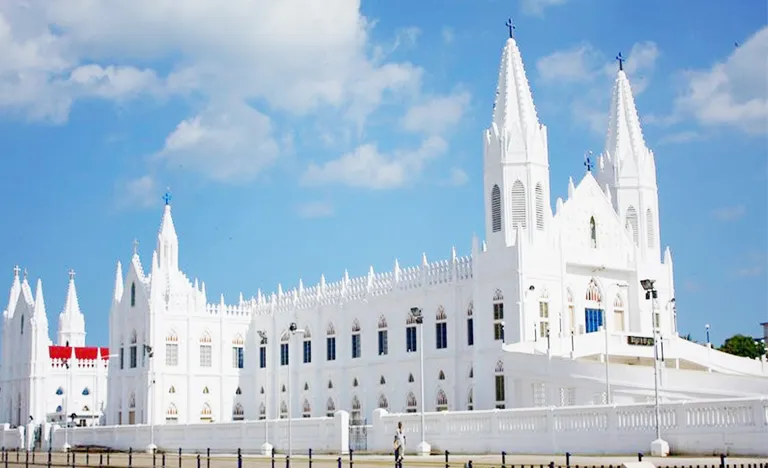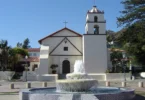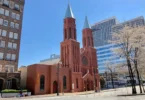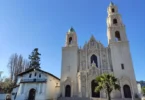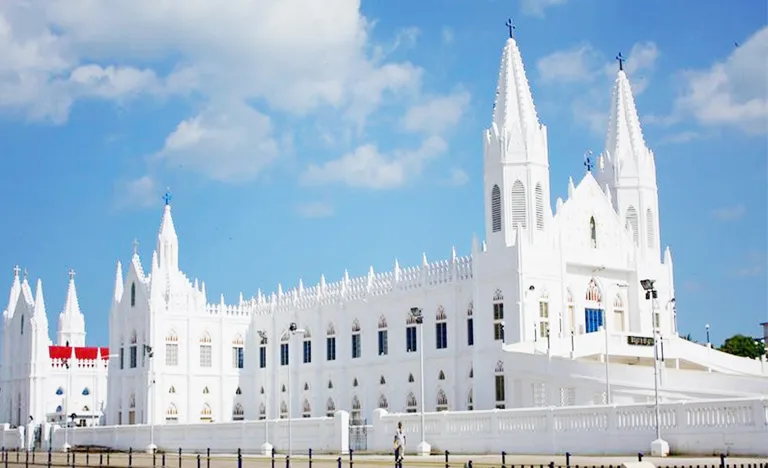
Introduction
Our Lady of Health Shrine Basilica, Vailankanni is home to one of the country’s biggest Catholic pilgrimage centres. The Catholic Basilica devoted to Our Lady of Good Health is popularly known as the “Lourdes of the East”. The origins of this church can be traced back to the 16th century and its founding is attributed to three miracles: The apparition of Mary and Jesus to a slumbering shepherd boy, the curing of a lame buttermilk vendor, and the survival of Portuguese sailors assaulted by a violent sea storm.
Our Lady of Health Shrine Basilica, Vailankanni is built in the Gothic style, was modified by Portuguese and then further expanded later on due to the influx of pilgrims. The church building was raised to the status of basilica in 1962 by Pope John XXIII. Annually, 20 million pilgrims flock to the shrine from all over India and abroad, out which an estimated 3 million people visit the shrine during its annual festival from 29 August to 8 September. The 11-day annual festival concludes with the celebration of the Feast on 8 September.
Tradition recounts that Mother Mary appeared with the Infant Jesus in this small hamlet at the end of the 16th or in the early 17th century. Ever since, Our Lady of Health Shrine Basilica, Vailankanni is the most important destination and almost the synthesis of all Marian Sanctuaries for the pilgrims of the world. The crowds of pilgrims come here regardless of creeds and languages.
Our Lady of Good Health, also known as Our Lady of Health Shrine Basilica, Vailankanni is a celebrated Catholic title of the Blessed Virgin Mary believed to have appeared in Velankanni Town, Tamil Nadu, India. According to traditional beliefs, the Marian apparition is said to have occurred to a young boy delivering milk to the neighbourhood when the Virgin Mary, carrying the child Jesus, is said to have appeared. This apparition has not been approved by the Holy See.
The Basilica of Our Lady of Good Health erected by the Portuguese and the Indians stands at this site. The iconic depiction of the Madonna is unique in that it is one of two only icons where Mary is portrayed wearing an Indian Sari, while the other statue is said to have been buried with Aurangzeb, the Mughal Emperor. The basilica is known as a site for pilgrims from all over India and its assembly of multilingual prayers every Christmas.
History of Our Lady of Velankanni
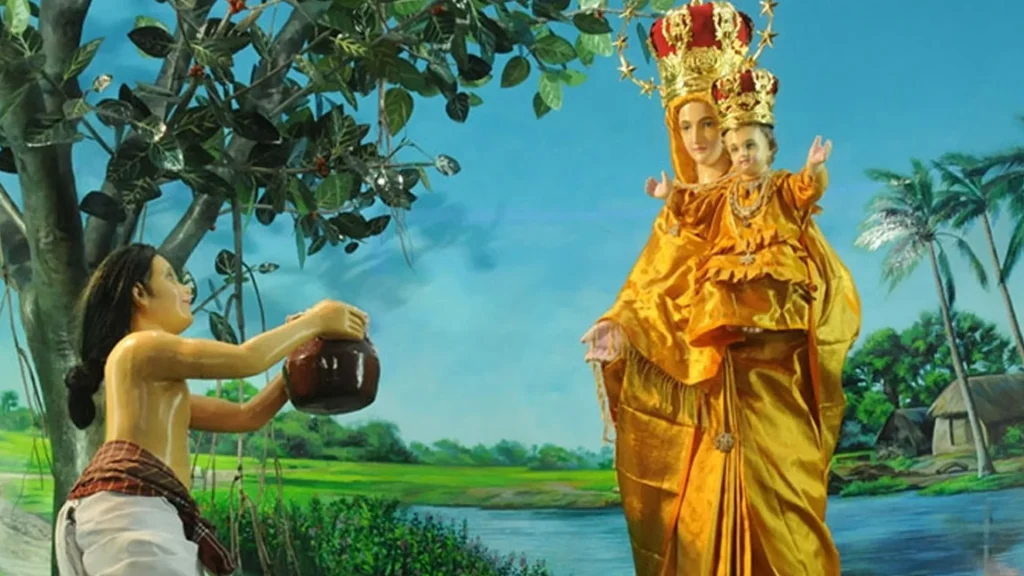
There are no historical documents or records about the apparitions of Mary at Velankanni. Oral tradition is the source for the two apparitions of the Blessed Mother of Velankanni in the 16th century and the saving of the Portuguese sailors from a tempest in the Bay of Bengal in the later 17th century.
The First Apparition is said to have occurred in May of 1570, when a local shepherd boy was delivering milk to a nearby house. Along the way he met a beautiful woman holding a child, who asked for some milk for the little one.After giving her the milk, he continued on his way, and upon making the delivery discovered that the jug was now completely full of fresh, cool milk.
The Second Apparition is said to have happened in 1597, not far from Matha Kulam. A beautiful woman with a young boy in her arms appeared to a young crippled boy selling buttermilk. The little boy asked for some buttermilk, and after he drank it, the woman asked the boy selling buttermilk to visit a gentleman in the next town and ask him to build a chapel in her honor at that location. The boy set out quickly and realized that he was no longer lame. A small thatched chapel was quickly built in honor of Our Lady of Health, called in Tamil “Arokia Matha”.
The Third Incident occurred when a Portuguese ship sailing from Macau to Sri Lanka was caught in a storm in the Bay of Bengal. They invoked the help of the Blessed Virgin under her title “Star of the Sea”. The storm subsided and the 150 men on board were saved. It was September 8, the Feast of the Nativity of Mary. In thanksgiving, the sailors rebuilt the Shrine to Our Lady of Good Health, and continued to enhance it whenever their voyages brought them to the area.
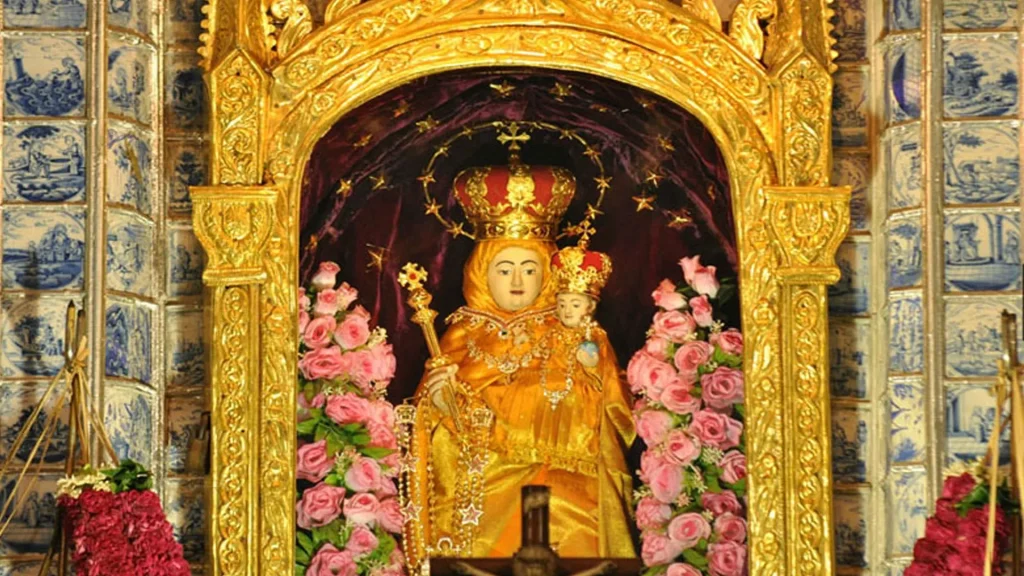
Our Lady of Health Shrine Basilica, Vailankanni that started as a thatched chapel in the mid-sixteenth century became a parish church in 1771 when Catholics in India were under persecution from the Dutch. Later in 1962 it was granted a Special status of a Minor Basilica by Pope John XXIII. The shrine of Velankanni was elevated to the status of ‘Minor Basilica’ and merged with the Major Basilica of Mary (Mary Majore) in Rome on 3 November 1962 by Pope John XXIII.
Velankanni was a part of the parish of Nagapattinam, but as pilgrims began to pour into Velankanni, it was raised to the status of an independent parish in 1771, and Fr. Antonio de Rozario the last parish priest of the Church of the Immaculate Conception, Nagapattinam, was appointed the first Parish priest of Velankanni.
Nagapattinam had always been under the ecclesiastical jurisdiction of the Bishop of the Diocese of Mylapore. During that period the Diocese of Mylapore was administered under the Portuguese ‘Padroado’ (patronage). Under the Padroado system, the king of Portugal in Europe met all the expenses incurred by the Diocese of Mylapore, which remained under the ecclesiastical jurisdiction of the Roman Pontiffs.
Until 1847 the priests of St. Franciscan Missionaries who had looked after the province of Goa and Mylapore also looked after Nagapattinam and Velankanni. The Franciscan origin and ownership of the Shrine was also perpetuated, by giving the place of honor to two Franciscan saints, St. Anthony of Lisbon and St. Francis of Assisi, on either side of the miraculous image of ‘Our Lady’, on the High Altar until 1961. Besides the last parish priest, Miguel Francisco Fernandez, who was of the Franciscan order, controlled the parish of Velankanni till 1889. In 1890 the parish was handed over to diocesan priests.
Thereafter, the diocesan priests of the Diocese of Mylapore were in charge of Velankanni. In 1952, when the new Diocese of Thanjavur came into being, and Velankanni became a part of the new diocese, the priests of Thanjavur Diocese became the custodians of the Shrine.
The administration of the new Diocese was imagesorarily placed under the apostolic administration of the Rt. Rev. Dr. Louis Mathias, S.D.B., who was then the Archbishop of the new Archdiocese of Madras – Mylapore.
On March 19, 1953, His Excellency the Rev. Dr. R. Arokiasamy Sundaram, DD., L. C. L., M. A., a priest of Mylapore Archdiocese was appointed as the first Bishop of the new Diocese of Thanjavur. He assumed charge of his Diocese on March 24, 1953. Velankanni being situated in the Thanjavur District came under the jurisdiction of the Diocese of Thanjavur.The Rev. Dr. R. Arokiasamy Sundaram showed keen interest in the development of Velankanni Shrine and granted special spiritual privileges. ‘Our Lady of Health Velankanni’ became the second patroness of our newly erected Diocese.
Elevation of the Shrine to the status of a Basilica
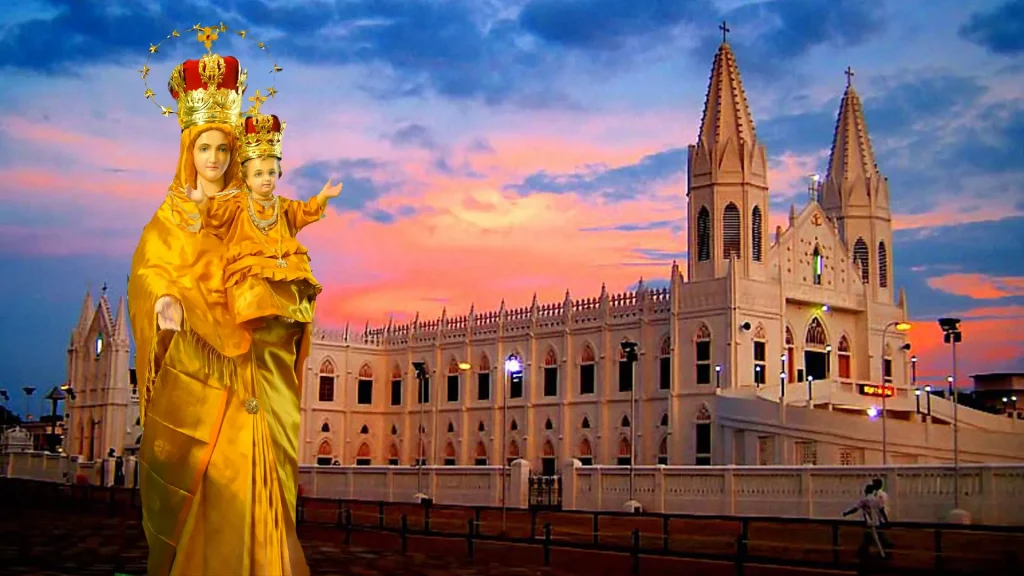
The greatest honour that can be conferred to a Church is to elevate it to the status of a Basilica. The word ‘Basilica’ is derived from the Greek word ‘Basilike’ and it originally signified a Royal Hall. In course of time this word has come to mean a large and beautiful hall. In ancient times kings from all over the world in general, and from Rome in particular, constructed large hall for administrative purposes. The first hall bearing the name of Basilica existed in Athens.
Jesus Christ being the King of Kings, and His Churches being His audience halls, the larger Christian Churches in Rome came to be called Basilicas. Today, a Basilica is a consecrated Church usually built with the front facing the East, and generally constructed in one of the classical styles of architecture.
It is oblong in shape with a broad nave ending in an apse. It is now stipulated that a church, in order to be called a Basilica, should contain some work of art, or it should contain some work of art, or it should house the body of a saint or a celebrated image much venerated in the land, or be a pre-eminent place of pilgrimage.
His Excellency, Dr. R.A. Sundaram D.D., L.C.L., M.A., the first Bishop of the diocese of Thanjavur, earnestly petitioned Pope John XXIII to raise the Shrine of Velankanni to the Status of a Basilica and also requested His Holiness to enrich it with all the privileges attached to a Basilica for the spiritual benefit of the pilgrims.
In 1962, when Bishop Sundaram went to Rome to attend the second session of the Second Vatican Council, he reiterated his request to the Holy Father personally to raise the Shrine of Our Lady of Velankanni to the lofty status of a Minor Basilica. After examining the request carefully, His Holiness Pope John XXIII, of saintly memory, issued orders raising the Shrine to the exalted status of a Minor Basilica. Thus the Shrine of Velankanni became the Shrine Basilica of Velankanni in November 1962 and was linked to the St. Mary’s Major Basilica in Rome.
Feast Days : 8th September
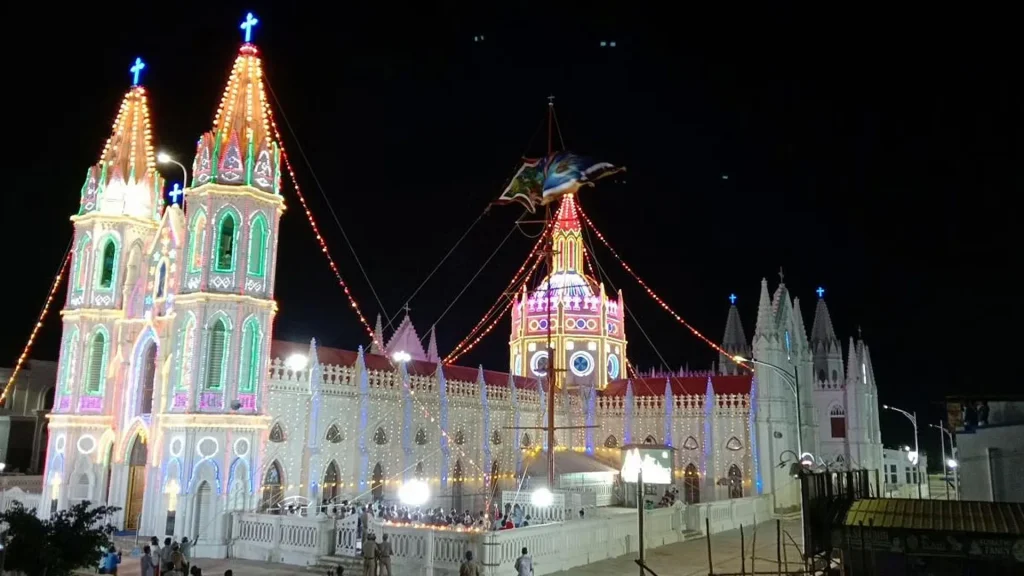
September 8, the Feast of the Nativity of Mary, is also commemorated as the feast of Our Lady of Good Health. The celebration starts on 29th August and ends on the day of the feast. The feast day prayers are said in Tamil, Malayalam, Telugu, Kannada, Konkani, Hindi and English.
- Feast is celebrated from 29th August to 8th September – 8th September the Birth Day of the Blessed Virgin Mary.
- More than 20 lakh pilgrims from all the corners of India and from other Countries throng the Shrine.
- Holy Mass is celebrated in six languages, fourteen times a day during the Feast.
- Car Procession of Our Lady of Health takes place at 08.00 p.m.
- Everyday hoisting of the Our Lady’s flag, takes place at 12.00 noon.
- The Grand Annual Feast commences with the hoisting of Our Lady’s Flag at 06.30 p.m. on 29th August. The Bishop of Thanjavur is the main celebrant on this day.
- The Feast concludes with the dismounting of Our Lady’s Flag at 06.00 p.m. on 8th September. The Rector & Parish Priest is the main celebrant on the concluding Mass.
- The Feast Mass is celebrated on 8th September at 06.15 a.m. in the Shrine open-air auditorium, presided over by the Bishop of Thanjavur.
Mass Time
Week Days
- 5.40 am : Morning Prayer in the Main Shrine
- 6.00 am : Mass in Tamil in the Main Shrine
- 7.00 am : Mass in Tamil in the Lower Basilica
- 8.00 am : Mass in Telugu in the Upper Basilica
- 9.00 am : Mass in Malayalam in the Lower Basilica
- 10.00 am : Mass in English in the Lower Basilica
- 11.00 am : Mass in Hindi in the Upper Basilica
- 12.00 noon : Mass in Tamil in the Lower Basilica
- 6.00 pm : Rosary and Litany in Tamil followed by Mass in Tamil in the Lower Basilica
All Sundays
- 7.30 am : Mass in Tamil in the Lower Basilica (Instead of at 7.00 am during the week)
- 5.00 am : (Additional) Mass in Tamil for the Parishioners of Vailankanni in the Lower Basilica
- 6.00 pm : Rosary, Novena Prayer, Benediction and Mass in Tamil in the Lower Basilica
All Saturdays
- 7.00 am : Mass in Tamil at Our Lady’s Tank Chapel
- 5.45 am : Car Procession of Our Lady of Health around the Shrine Benediction and Mass in Tamil in the Lower Basilica
First Friday
- 6.00 pm : Mass in Tamil Eucharistic Procession around the Shrine Sermon and Benediction from the front view of the Upper Basilica
First Saturday
- 5.30 pm : Car Procession of Our Lady of Health thought the Beach Road Blessing of the Sick with the Blessed Sacrament Benediction and Mass in Tamil in the Lower Basilica
- 9.00 pm : A Three-Hour Adoration to the Blessed Sacrament in the Main Shrine
Second Saturday
- 9.00 am : A Healing and Fasting Prayer Service from 9 am to 4 pm at Vailankanni Retreat House
Third Saturday
- One Hour Intercessory Prayer Service at Our Lady’s Tank Chapel after 7.00 am Mass
Fourth Saturday
- 6.30 am : Mass in Tamil at Naduththittu Chapel
- 8.00 pm : Children’s Evangelization Programme in front of the Presbytery
Month of May
- Our Lady’s Car Procession around the Shrine on all the days
Other Facilities
Office
The Shrine office functions from 09.00 a.m. to 05.30 p.m. with a break for lunch between 12.30 noon to 02.00 p.m. Sundays, New Year Day, Good Friday and Christmas are holidays for the office. The office is a prime help to the Rector and Priests; backbone of the administration besides dealing with Sacramental records.
Museum
Open from 06.30 a.m. to 08.00 p.m. every day. Offerings of gold, silver other metals and kinds, received from pilgrims, are displayed here. The Museum stands as a live-witness to Our Lady’s blessings upon her devotees and to the gratitude of pilgrims.
Depot
The depot is at the ground floor of the parochial house, displays religious articles, statues, audio & video cassettes. It has a branch at Our Lady’s Tank. In the beginning, it was known as Legion of Mary book depot.
Book Center
A book stall known as ‘Annai Book Centre’ is located in the museum with its branch down the museum.
School
- Our Lady of Health Higher Secondary School.
- Our Lady of Health Middle School.
- Our Lady of Health Elementary School.
- Infant Jesus Primary School (English Medium).
- Christ the King High School special school for handicapped and Deaf & Dumb Children.
Charity Institutions - Homes
- Karunai Illam – A Home for physically handicapped and Deaf & Dumb Children – runs by Sisters of Jesus Congregation.
- ‘Nirmal Hriday Home’ – A home for mentally retarded children – run by sisters of ‘Missionaries of Charity’.
- St.Joseph’s Home – For Aged’ (for men and women).
Hospital
Our Lady of Health Hospital with a dispensary.
Movie
A Tamil language movie was made in honor of Our Lady of Good Health with the title Annai Velankanni in 1971. The movie was directed by K. Thankappan, starring major stars of Tamil cinema including Gemini Ganesan, Kamal Haasan, K. R. Vijaya and Padmini.
Contact Info
Rector, Shrine Basilica
Vailankanni – 611 111.
Nagapattinam District
Tamilnadu, INDIA
Phone No.
+91 – 4365 263 423
+91 – 4365 263 584
+91 – 4365 264 890
E-Mail Id: info@vailankannishrine.net, rector@vailankannishrine.net
Accommodations
Connectivity
Velankanni is well connected by Road and Rail to the rest of the country. The East Coast Road (ECR) that runs from Chennai to Cuddalore connects the town to the rest of the country.
Airways
The nearest airport are Tiruchirappalli Airport (60.8 Kms) and Chennai Airport (306 Kms) from Our Lady of Velankanni.
Railways
The nearest railway station is Velankanni Railway Station which is (900 Meters) from Our Lady of Velankanni.
Roadways
Our Lady of Velankanni is (95.2 Kms) from Thanjavur Old Bus Stand, (102 Kms) from Thanjavur New bus stand, (157 Kms) from Trichy Central Bus Stand.

